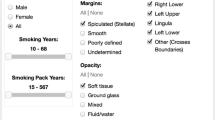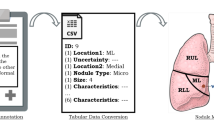Abstract
A large number of lung nodule prediction models have been developed by scientific societies, such as the Brock University (BU) model and the Mayo Clinic (MC) model, which are easy to apply by the general public and researchers. However, there are few existing web servers that can combine these models. TB-LNPs (Tool Box of Lung Nodule Predictors) is a web-based tool that provides fast and safe functionality based on accessible published models. TB-LNPs consists of four segments, including ‘Home’, ‘About Us’, ‘Manual’, and ‘Tool Box of Lung Nodule Predictions’. We give extensive manual guiding for TB-LNPs. In addition, in the ‘Tool Box of Lung Nodule Predictors’ part, we reconstructed six published models by R and constructed a web server by Spring Boot. TB-LNPs provides fast interactive and safe functions using asynchronous JavaScript and Data-Oriented Security Architecture. TB-LNPs bridges the gap between lung nodule prediction models and end users, thus maximizing the value of lung nodule prediction models. TB-LNPs is available at http://i.uestc.edu.cn/TB-LNPs.
H. Luo, N. Lin, L. Wu, Z. Huang and R. Zu—Contributed equally to the work presented here and should therefore be regarded as equivalent authors.
Access this chapter
Tax calculation will be finalised at checkout
Purchases are for personal use only
Similar content being viewed by others
References
Siegel, R.L., Miller, K.D., Jemal, A.: Cancer statistics, CA Cancer J. Clin. 70, (2020)
Massion, P.P., et al.: Assessing the accuracy of a deep learning method to risk stratify indeterminate pulmonary nodules. Am. J. Respir. Crit. Care Med. 202, 241–249 (2020)
Aberle, D.R., et al.: Reduced lung-cancer mortality with low-dose computed tomographic screening. N. Engl. J. Med. 365, 395–409 (2011)
Gould, M.K., et al.: Recent trends in the identification of incidental pulmonary nodules. Am. J. Respir. Crit. Care Med. 192, 1208–1214 (2015)
McWilliams, A., et al.: Probability of cancer in pulmonary nodules detected on first screening CT. N. Engl. J. Med. 369, 910–919 (2013)
Hawkins, S., et al.: Predicting malignant nodules from screening CT scans. Journal of Thoracic Oncology: Official Publication of the International Association for the Study of Lung Cancer 11, 2120–2128 (2016)
Gould, M.K., Ananth, L., Barnett, P.G.: A clinical model to estimate the pretest probability of lung cancer in patients with solitary pulmonary nodules. Chest 131, 383–388 (2007)
Kymes, S.M., Lee, K., Fletcher, J.W.: Assessing diagnostic accuracy and the clinical value of positron emission tomography imaging in patients with solitary pulmonary nodules (SNAP). Clin. Trials. 3, 31–42 (2006)
Zu, R., et al.: A new classifier constructed with platelet features for malignant and benign pulmonary nodules based on prospective real-world data. J. Cancer 13, 2515–2527 (2022)
Luo, H., Zu, R., Li, Y., Huang, J.: Characteristics and diagnostic significance of peripheral blood T-cell receptor repertoire features in patients with indeterminate lung nodules. Available at SSRN: https://ssrn.com/abstract=3978572 (2022)
Chung, K., et al.: Brock malignancy risk calculator for pulmonary nodules: validation outside a lung cancer screening population. Thorax 73, 857–863 (2018)
Swensen, S.J., et al.: The probability of malignancy in solitary pulmonary nodules. Application to small radiologically indeterminate nodules. Arch. Intern. Med. 157, 849–855 (1997)
Choi, H.K., Ghobrial, M., Mazzone, P.J.: Models to estimate the probability of malignancy in patients with pulmonary nodules. Ann. Am. Thorac. Soc. 15, 1117–1126 (2018)
Herder, G.J., et al.: Clinical prediction model to characterize pulmonary nodules: validation and added value of 18F-fluorodeoxyglucose positron emission tomography. Chest 128, 2490–2496 (2005)
Gurney, J.W., Swensen, S.J.: Solitary pulmonary nodules: determining the likelihood of malignancy with neural network analysis. Radiology 196, 823–829 (1995)
Gurney, J.W.: Determining the likelihood of malignancy in solitary pulmonary nodules with Bayesian analysis. Part I. theory. Radiology 186, 405–413 (1993)
Soardi, G.A., Perandini, S., Motton, M., Montemezzi, S.: Assessing probability of malignancy in solid solitary pulmonary nodules with a new Bayesian calculator: improving diagnostic accuracy by means of expanded and updated features. Eur. Radiol. 25(1), 155–162 (2014). https://doi.org/10.1007/s00330-014-3396-2
Deppen, S.A., et al.: Predicting lung cancer prior to surgical resection in patients with lung nodules. Journal of Thoracic Oncology: Official Publication of the International Association for the Study of Lung Cancer 9, 1477–1484 (2014)
Acknowledgements
HC.L. and Z.H. built the server base system; L.W. and HC.L. designed the user interface; J.H. obtained funding and supervised the project, and oversaw the manuscript preparation.
Funding
This study was supported by grants from the Sichuan Medical Association Research project (S20087), Sichuan Cancer Hospital Outstanding Youth Science Fund (YB2021033), and the National Natural Science Foundation of China (62071099).
Author information
Authors and Affiliations
Corresponding author
Editor information
Editors and Affiliations
Rights and permissions
Copyright information
© 2022 The Author(s), under exclusive license to Springer Nature Switzerland AG
About this paper
Cite this paper
Luo, H., Lin, N., Wu, L., Huang, Z., Zu, R., Huang, J. (2022). TB-LNPs: A Web Server for Access to Lung Nodule Prediction Models. In: Huang, DS., Jo, KH., Jing, J., Premaratne, P., Bevilacqua, V., Hussain, A. (eds) Intelligent Computing Theories and Application. ICIC 2022. Lecture Notes in Computer Science, vol 13394. Springer, Cham. https://doi.org/10.1007/978-3-031-13829-4_36
Download citation
DOI: https://doi.org/10.1007/978-3-031-13829-4_36
Published:
Publisher Name: Springer, Cham
Print ISBN: 978-3-031-13828-7
Online ISBN: 978-3-031-13829-4
eBook Packages: Computer ScienceComputer Science (R0)




